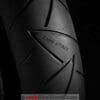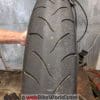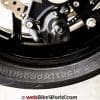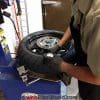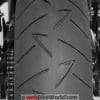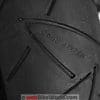The Continental Road Attack 2 EVO is a sport-touring tire with the grip of a Hypersport tire.
The handling is definitely different from other similar motorcycle tires but you’ll quickly adjust.
Wet traction and braking with the Road Attack 2 EVO tires is superb and the tires inspire confidence.
This review marks the second time I’ve been given the opportunity to review motorcycle tires from Continental for webBikeworld.
Earlier this year, I had the opportunity to try the Continental Sport Attack 3 tires (review) at Continental’s proving grounds in Uvalde, Texas.
At that event I not only had the opportunity for some extended time riding with what was then their latest street tire on the Continental test track, i also learned some things about Continental as a company and what they do in addition to making tires.
That look at the Sport Attack 3 tires provided a small window of time on to put the tires through their paces.
And with just a half-day and two separate road tracks to try, those tires performed superbly. I was impressed.
The weather was great and since we didn’t get any time on the wet traction skid pad (none of us there wanted to do that anyway) all I could evaluate was dry road traction and “feel” on the “perfect” test track road surface.
While I was there I took the time to ask about the differences between the Sport Attach and the Road Attack series tires.
Contintental’s Road Attack family of tires are the sport-touring street-focused sibling of the “Hypersport” tire series known by the “Sport Attack” label.
The Continental Road Attack 2 EVO tires were first released in 2013 and the Continental representatives told me that I should really try the the Road Attack 2 EVO tires for comparison.
They said that a lot of the technology that went into the new Sport Attack 3 tires actually came from the Road Attack 2 EVO tires and if I liked the former, then I should be very pleased with the latter, especially in the “real world” of street use.
Of course, I had to find out!
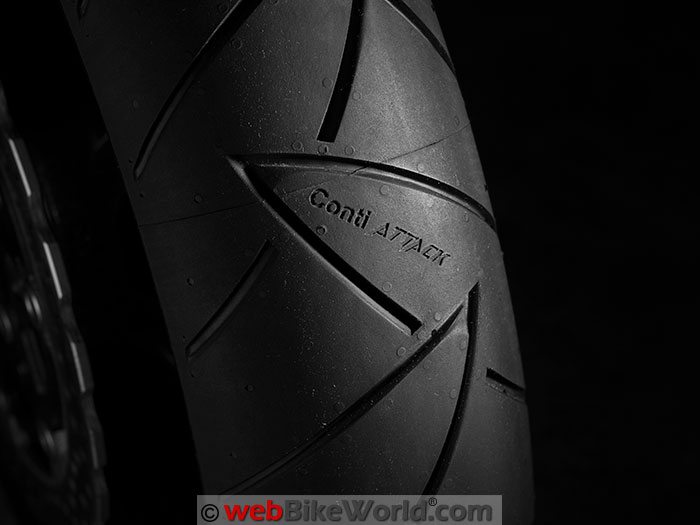
Road Attack vs. Road Attack 2 vs. Road Attack 2 EVO
The Road Attack 2 EVO tires are, like their name implies, an evolution of the original Road Attack and Road Attack 2 tires, both of which are also still listed in the Continental motorcycle tire catalog.
The tread pattern on all three is very similar and at first glance it might be easy to miss the differences in appearance.
In fact, it’s very difficult to see any differences at all in the tread design of the front Road Attack, Road Attack 2 and the Road Attack 2 EVO tires.
The rear tires also have a similar tread design but the “V”-shaped grooves on the Road Attack 2 and the EVO rear are slightly smaller or shorter than the grooves on the original Road Attack.
Of course, the EVO brand stamped into the sidewall next to the Road Attack 2 name dispels any confusion.
Looking at the sidewall shows how Continental takes a little extra time to add some design touches just for the sake of appearance.
For example, the Continental logo is embossed on the sidewall flanked with a checkerboard graphic pattern and Continental has placed it so the logo and the base of the letters are correctly oriented for reading when the letters are rotated at the bottom.
The tread pattern and sipes on the front of the Road Attack 2 EVO tires are similar to the Road Attack 2 tires with swoopy, curved delta shapes crossing over the the surface at an angle.
The Road Attack and Road Attack 2 EVO and EVO tires use a similar pattern but the delta shape is more sharply angled.
The sipes cross over the center back and forth, leaving no empty channel around the middle. This pattern is designed to promote water dispersion from the motorcycle’s single track.
The original Road Attack tires had a unique look and though modified from the original series, the new EVO tires still have a very different and recognizable pattern compared to most other motorcycle tires.
The rear tread pattern is made of a mixture of straight and sharply angled sipes and grooves that resemble a check mark with no curve.
The “checks” are placed in the middle third of the tread while the straight sipes run almost to the sidewall in alternating lengths.
The rear pattern leaves a small center space that has no sipes crossing it.
In theory, the front tire pattern moves water out of the way so the rear shouldn’t have to contend with as much water, at least when the bike is moving in a straight line.
This provides a strip of maximum traction which is also when the most power would be put to the rear wheel.
Sometimes the absence of any tread pattern crossing the center of the tire can be worrisome because then there is no good indicator of when the tire is worn out.
The strip in the center of the Road Attack 2 EVO tires is very narrow. At only 9.5 mm, I would guess that the edges of the tread sipes would likely become worn along with the center to indicate wear. We’ll see as I pile on more miles.
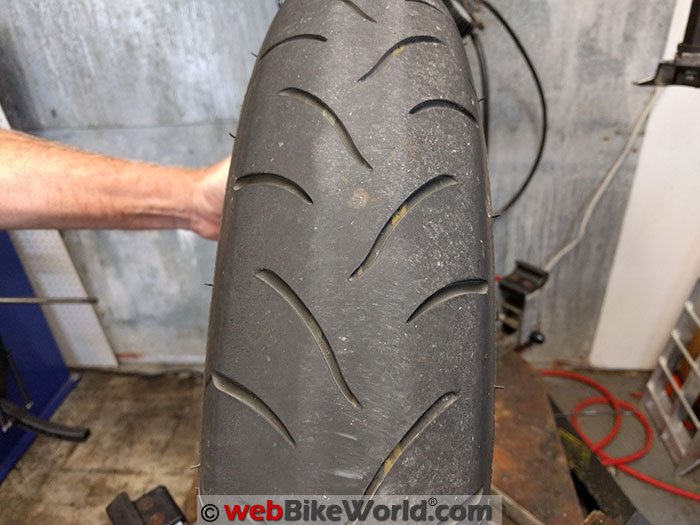
Technology
I mentioned earlier that a lot of the technology that went into the Sport Attack 3 Hypersport tire came from technology originally developed for the Road Attack series.
One of those technologies is called “MultiGrip”, which provides variable traction across the tread without using different compounds.
The tires are cured using varying degrees of heat from center to edge, which creates a continuous change in grip rather having to use separate sections.
Continental said that this makes the changeover as you lean the bike smoother and it also makes the tire’s surface wear more evenly over time.
In comparison, you can see in the photo above how a multi-compound tire like the OEM Bridgestone BT-016 show a distinct difference in the tread surface.
The tire shown in this photo was standard equipment on the Kawasaki Ninja 1000 (review).
Another Continental technology is called “TractionSkin“, which acts to make the tire achieve high levels of grip thanks to the way the surface maintains a very fine texture as it wears.
According to Continental, the surface texture allows the tire to “squish” into imperfections in the road creating better traction.
Can I feel it through the clip-ons? I’d like to think I can but I doubt it can be perceived that way.
I can definitely feel it on the surface of the tire by hand, however — even after hundreds of miles of wear, it doesn’t get completely smooth and the texture can still be felt on the tire (the photos of the wet tire in the slide show plainly show the texture).
The TractionSkin molding process also allows the manufacturer to eliminate tire mold release compounds, which is a big plus.
Sure enough, the textured surface of the Road Attack 2 EVO tires feels very grippy when brand new.
Break-in is claimed to be very short according Continental and while I don’t doubt it, I still found myself taking it easy the first 100 miles after getting the tires installed. Old habits die hard…
One more technology included with the Road Attack 2 EVO tires is the zero-degree steel belted construction. Continental says this type of construction provides “outstanding stability at high speeds and low kick-back tendency”.
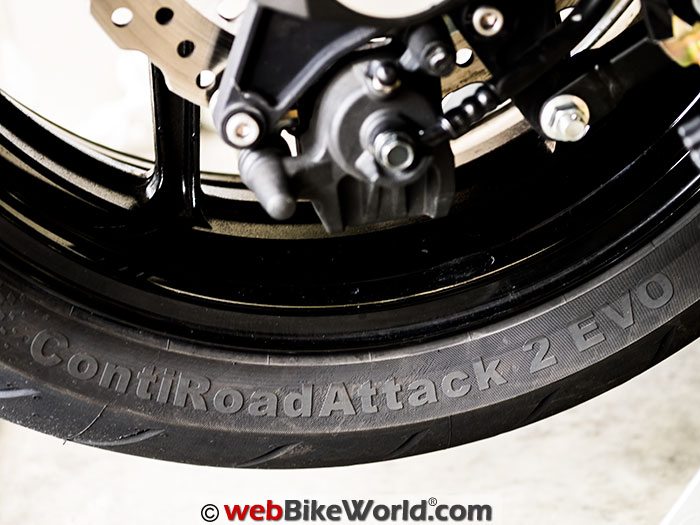
Installation
I delivered the new set of Road Attack 2 EVO tires to Top Dead Center Cycle in Nashville for mounting and balancing.
Over the past several years I have spent a lot of time at this shop working on my bikes and helping my friend who owns the shop.
This afforded me the chance to closely observe the tire mounting process and see how easy (or difficult) it would be to mount the tires onto the rims.
After removing the stock rubber, the Road Attack 2 EVO tires went on to the rims with little fuss.
We used a hydraulic tire machine for this but even with a “pro” tool like this, some tires can be problematic. There were no issues here.
Balancing was next and curiously, there were no dots to mark the light points on the tire. Not all manufacturers do this but it can be handy to line up that point with the valve stem to make balancing easier and use a little less weight.
Balancing the rear wheel took only 0.5 ounces but the front required 1.5 ounces to bring it to perfect balance.
It’s unknown whether this was due to the tire or the wheel, but any more weight than this and we would have dismounted the tire and rotated it on the rim to try and improve balance.
Sizes
The Road Attack 2 EVO tires are primarily designed for sport touring, according to Continental, although the front is available in both 17″ and 19″ sizes. Sizes include the following:
- 120/70 ZR 17 M/C 58 W TL
- 110/80 ZR 19 M/C 59 V TL
- 150/70 ZR 17 M/C 69 V TL
- 160/60 ZR 17 M/C 69 W TL
- 180/55 ZR 17 M/C 73 W TL
- 190/50 ZR 17 M/C 73 W
- 190/55 ZR 17 M/C 75 W TL
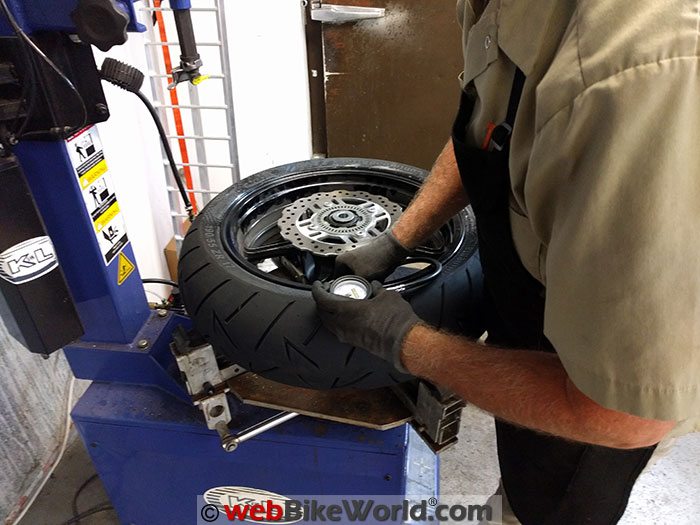
Performance and Handling
My Ninja 1000 is a sport touring machine with the emphasis on sport. That may be why Kawasaki chose to go with the Hypersport Bridgestone BT-016 tires as original equipment.
These are very high performance tires for modern sportbikes and they do have excellent grip, but for my style of riding and the sport touring mission I see the Ninja 1000 taking on, I don’t feel these were ideal.
The NInja feels a little nervous and wants to tip very quickly into turns with the stock Bridgestone tires. That might be OK for a supersport bike like a ZX-10, but for the heavier and more upright NInja 1000, it didn’t inspire confidence, for me anyway.
When cornering at lower speeds (20-30 mph) the bike wanted to fall into turns and had to be held into place to maintain a line.
At higher speeds this didn’t come into play and seems to prove the point that the BT-016’s are more at home in higher speed situations.
All this preamble is important because one tire may perform great on some bikes and be less than stellar on others.
The riding style and skill level of the rider also comes into play so I’m trying to make clear what I’m experiencing on my machine and how I ride it.
In the past, I’ve ridden on the original Road Attack tires as well the first and second generation Sport Attack tires on my own motorcycles and I liked the handling and feel I experienced with those tires.
They had characteristics I hoped would change the handling of the Ninja in a way I would appreciate, assuming that character was also present in the Road Attack 2 EVO.
I was not disappointed!
After the first 400 miles, I’d have to say I was impressed. The handling and feel has changed dramatically with the Road Attack 2 EVO tired spooned onto the wheels.
The rounder profile of the Road Attack 2 EVO changes the way the bike tips into turns.
And like the earlier generation of Road Attack tires I have tried, the profile makes tip in a little slower than some tires like the BT-016 but the extra effort needed to coax them into initiating a turn is pretty small.
It is something that you quickly become accustomed to after just a brief time and this has the added benefit of increased straight-line stability on the interstate highways.
My seat-of-the-pants feeling is that this current generation of Road Attack 2 EVO tires has a little more aggressive turn-in than the first generation I was familiar with, but not much.
A characteristic I really like that was also true of the early Road Attack tires and also the Sport Attack 3 tires I used during the Conti track day is the progressive way that lean is handled.
The Road Attack 2 EVO tires have the same characteristics.
As you lean over farther and farther, it takes increasingly more effort at the grips to push the bike over. This is not a bad thing and I like how this works and the resulting feel and feedback helps me settle into the angle I want.
The Road Attack 2 EVO tires want to hold a line once chosen and this has worked wonders on the Ninja 1000 and nearly eliminates its tendency to want to fall into turns at lower speeds.
I think the geometry of the Ninja 1000 still influences this a little bit and it cannot be entirely eliminated by tires, but overall, the handling is definitely better for me with the Road Attack 2 EVO tires.
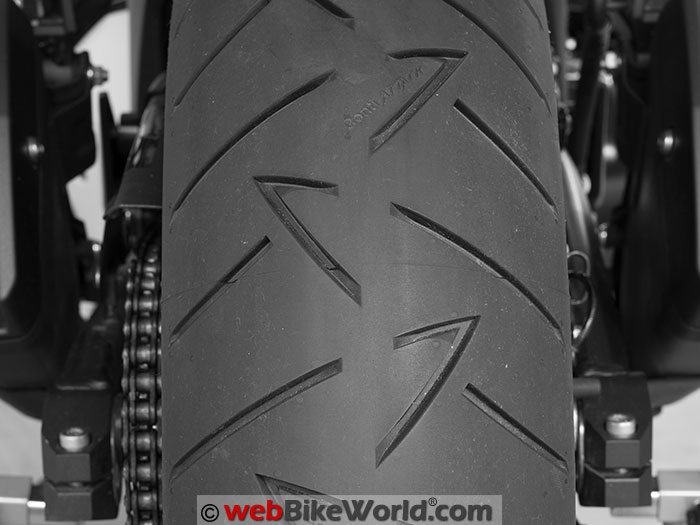
Overall Grip
This feeling can be subjective, but the amount of grip is more objective and I can say that I cannot (or am unwilling to) find the limits of the traction with the Road Attack 2 EVO tires. They feel very planted and stable.
I know that the original Bridgestone “Hypersport” tires perhaps are designed to provide more ultimate grip than the Continental Road Attack 2 EVO “sport touring” tires (or maybe not).
But to me, the Road Attack 2 EVO tires feel very connected to the road surface and are very confidence-inspiring.
In fact, I have found myself riding my daily back-road commuting route with more smiles and much less drama with the Continentals.
Tire Feedback
This leads me to tire feedback. Some tires I have used offered excellent grip but gave a “dead” or null feeling through the handlebar.
This behavior leads to advice from fellow riders like “You have to just trust that your tires will grip”. Sorry — I’m not keen on that feeling.
The Road Attack 2 EVO tires offer excellent feedback, much like the Sport Attack 3 tires did at the test track earlier this year. Road surface changes can be felt easily and the information comes through the grips without being harsh or busy.
I’d also say the Road Attack 2 EVO sidewalls are in the sweet spot between flexible and stiff. I’ve had tires with very stiff sidewalls before and they felt “dead” in the feedback department as well as making for a harsh ride.
One last dry riding test was to head out onto one of our interstate bypasses that has heavily grooved pavement. This roadway has been a great place for me to test tires for their reaction.
The Road Attack 2 EVO tires definitely felt less connected but they did very good job of maintaining a straight path down the road.
But the lack of small tread blocks and/or longitudinal sipes running down the middle of the tires helps provide stability on this kind of surface.
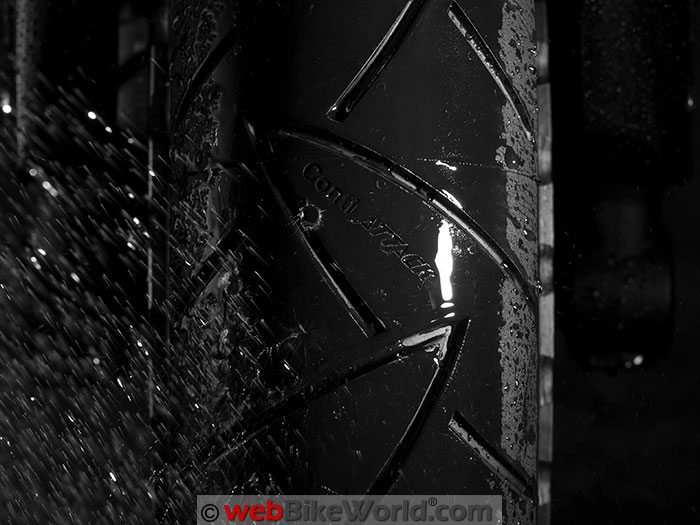


Wet Traction
One more Continental technology — “RainGrip” — is used in the compounds found in the Road Attack 2 EVO tires and also in the Sport Attack 3.
I didn’t get to test the Sport Attack tires in the wet while at the track day in Texas, but nature provided the opportunity here at home for the Road Attack 2 EVO tires.
During the first 400 miles on the Road Attack 2 EVO tires I had the “good” fortune of being caught in two heavy downpours. The “good” fortune is that I can report on how these tires handle in the wet.
My route to and from work takes me through some rural back roads as well as suburban areas.
I have a mixture of “not bad” and “needs improvement” road surfaces over a 13 mile stretch where I can put motorcycle tires to the test.
One day, I found myself at my office with an absolute deluge of rain coming down and it looked like it wasn’t going to stop for some time, so I decided to take the plunge (pun!) and find out how the new Road Attack 2 EVO tires would handle it.
The roads I was riding on had good drainage in most places but there were several stretches with spots of standing water.
As I took the turns and curves I proceeded slowly as I normally do in the rain.
The Road Attack 2 EVO tires performed very well and continued to do so as I started to increase my turning speeds.
Of course, I never reached the speeds I would usually ride in the dry but I did end up going a little faster than I normally would in the rain and the tires felt well connected, even in places with standing water.
While I was unwilling to push the bike and the Road Attack 2 EVO tires too hard into turns on the wet streets, I did explore some braking limits.
I used to feel that ABS wasn’t necessary on modern motorcycles if you’re a good rider, but even good riders can make mistakes and having tested ABS on this and other bikes I felt it was safe enough to try some straight line braking tests in the rain.
There were plenty of opportunities on the way home with no cars in sight, so when I had a nice long straight coming up I started doing some quick stops.
At first I was easing into the brakes as I usually would on wet streets, but then I continued to push my luck further and further by stopping quicker and quicker on the rain-soaked roads.
By the time I reached home, I had performed at least a dozen hard stops on the road and the Road Attack 2 EVO tires never shrugged.
Each stop was clean and straight and I could never even trip the ABS to intervene.
I have stopped harder in dry conditions but I stretched past my normal wet braking comfort margin four or five times (and I decided I would stop pressing my luck at that point).
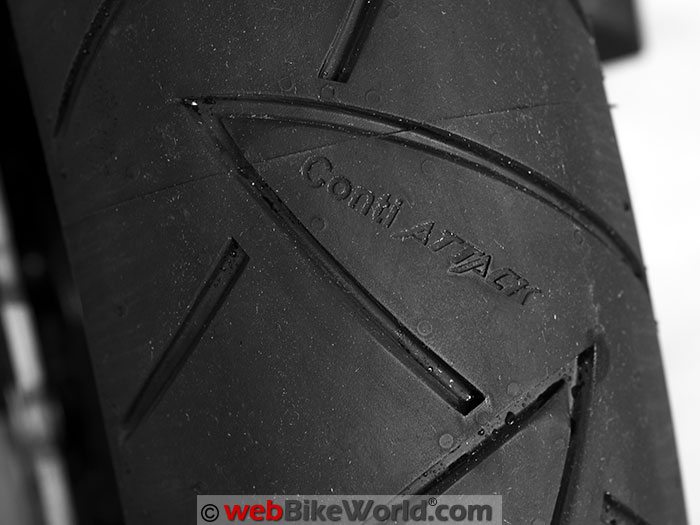


Conclusion
The Road Attack 2 EVO tires do not disappoint.
This latest generation of Continental’s sport-touring rubber delivers on the mark for grip both in the wet and dry conditions.
The handling strikes a nice balance between “Hypersport” and sporting or sport-touring characteristics. While this is a very subjective area I find the character fits my riding style very well.
The family resemblance between the current Sport Attack and Road Attack tires is also demonstrated in the feel and feedback of both.
“Confidence-inspiring” is a great way to describe the Road Attack 2 EVO tires.
I think they compete well in the space against other brands of sport-touring tires in both performance and in price.
Longevity is the only aspect I cannot speak to yet but I intend to follow up as they get close to their end of life to comment on any performance changes as well as the overall life span.
Owner Comments and Feedback
See details on submitting comments.
From “A.S.” (September 2016): “Nice review. I have been riding Conti Road Attack, Attack 2 and as of last year Attack 2 EVO. I ride a BMW K1200R Sport 2007MY and Kawasaki ZZR 1200 2002MY.
What you wrote is spot on. Rain confidence is excellent, stability in the turn is solid with a little extra bar push, tire wear on super slab shows little wear down the center.
For more than 10 years I have always gone back to Conti Road Attack family for performance, confidence and wear. None of my local dealers in Phoenix AZ stock the tires, always are ordered in.
Nice to read a September 2016 review on my favorite tire, not much other reviews out there! Thanks and Cheers!”
From “D.W.” (September 2016): “Great review, and I have a new (to me) BMW F650CS with the original Road Attacks and agree the grip is outstanding. Not a single bit of slide that wasn’t gravel or me being silly.
I was planning to go to Pilot Road 4’s after these, since I liked them on the old K1200R and the mileage was really impressive. Have you tried those in comparison?”
Editor’s Reply: We haven’t reviewed the Michelin Pilot Road 4 but we have reviewed the Michelin Pilot Road 2 (review) and Michelin Pilot Road 3 (review).
The Pilot Road 2 tires felt a bit strange at first on the BMW F800S (Blog), but now they’re fantastic, I really like them on that great-handling, low center of gravity bike and don’t even want to try anything different.
From “D.P.” (September 2016): “I’ve recently become aware how seldom I try out different tyres/manufacturers. Been buying Bridgestone since being scared witless by Dunlops that folded the front every time they encountered a corner — 20 years ago.
Nnever tried Michelin, had interesting times on the first generation Rennsports by Metzler, which ultimately convinced me that I really don’t need semi slicks for road use, especially on our cold and damp British roads.
I switched to sport touring tyres and never looked back .
I’m very tempted to give these new continentals a spin. Many thanks for the review.”
From “M.G.” (September 2016): “I found out exactly the same what you saying after switching from Bridgestone T30 Evo to Pirelli Angel GT.
Much better feedback, better line holding, confidence inspiring. T30 were good, no issues even pushing it in the rain, but no feel.
And I’ve got 5200 miles from the rear and we’ll over twice that from the front. Now on the Angels I’ve got almost 4k miles, and by the looks it has half of the thread still left.
Really interested to see what mileage you’ll get. BTW, bike’s Aprilia Caponord with increased power and scraped footpegs.”
From “J.W.” (September 2016): “I would be really interested in finding out the kind of mileage you wind up getting with these tires. For those of us sport touring riders with the emphasis on touring that’s a pretty important issue.
My Suzuki Bandit 1250 went through the Dunlop Sportmax rear tire in 3800 miles which is not great when you figure I can put 1700 miles on in a 4-day weekend. I am now trying the Metzeler Roadtec 01 and we’ll see how it goes.”


